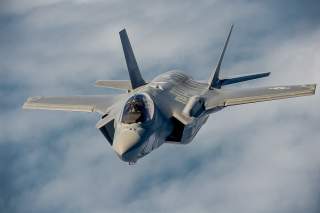The F-35 Is About to Get Its First Taste of Modern War
Here's what we can expect.
The Air Force's variant of the F-35 Joint Strike Fighter has arrived at Al Dhafra Air Base, United Arab Emirates in the U.S. Central Command area of responsibility to fly combat operations if needed, a defense official said on Monday.
"They were already scheduled to come out here for an exercise," the defense official told Task & Purpose. "But they are operational, so when or if they get called to get on an ATO [air tasking order], they will be on one."
While Marine Corps F-35Bs flew more than 100 combat sorties against ISIS and the Taliban last year, this is the first time that Air Force F-35As have deployed to the CENTCOM theater of operations.
Their arrival comes nearly a month after ISIS lost its last enclave in Syria.
The F-35As come from the active-duty 388th and reserve 491th Fighter Wings based out of Hill Air Force Base, Utah, according to U.S. Air Forces Central Command.
An AFCENT spokeswoman declined to specify exactly how many of the aircraft are now in theater, citing operational security concerns.
"This is a rotational deployment," said Maj. Holly Brauer. "They are going to be participating in some exercises coming up. It's a usual rotation."
The F-35 is meant to be able to operate within the world's deadliest air space, such as within the range of Russian or Chinese air defense systems. In addition to being stealthy, F-35s have a suite of sensors that allows them to detect enemies in the air and on the ground much further away than older U.S. aircraft.
But the F-35 program has run into cost overruns, problems, and lengthy delays that have forced the U.S. military to fly their legacy aircraft much longer than originally intended.
Nearly two decades since the program began, every F-35 variant remains beset by technical glitches. The Defense Department's 2018 research, development, test, and evaluation report found the F-35A's cannon, which is meant to attack ground targets, has an accuracy best described as "unacceptable."
"Although software corrections were made to the F-35 mission systems software to improve the stability of gun aiming cues, no software or hardware corrections have yet been implemented to correct the gun accuracy errors," the report stated. "Investigations into the gun mounts of the F-35A revealed misalignments that result in muzzle alignment errors. As a result, the true alignment of each F-35A gun is not known."
Despite this, Air Force Chief of Staff Gen. David Goldfein said in February that he had not seen reports about significant problems with the F-35A's gun.
"Given what we've built the F-35 to do, I'm not sure that the gun is going to be the first place I would focus on," Goldfein said at the liberal Brookings Institution think tank in Washington, D.C. "When we talk about fifth generation [fighters], stealth is actually only a small part of that. When we talk about fifth generation, it's about information fusion and being able to have displayed for you information that was not available."
This article by Jeff Schogol originally appeared at Task & Purpose. Follow Task & Purpose on Twitter. This article first appeared in 2019.
More Articles from Task & Purpose:
- 7 Veteran-Friendly Manufacturers That Are Hiring
- The 6 Types Of Contractors You Encounter Overseas
- Here’s How Marines Fared On The New Physical Fitness Test
Image: Wikimedia

